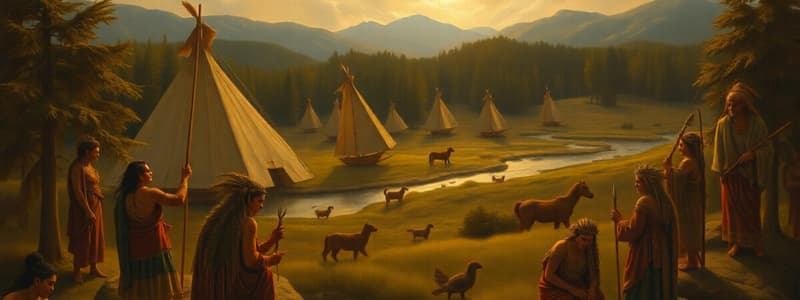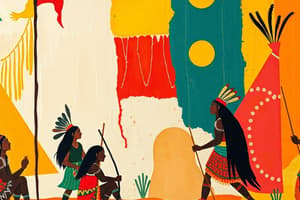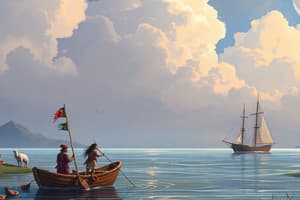Podcast
Questions and Answers
Which theory regarding the arrival of people in the Americas is supported by the most evidence?
Which theory regarding the arrival of people in the Americas is supported by the most evidence?
- African Theory
- Oceania Theory
- Bering Land Bridge Theory (correct)
- Atlantic Theory
The Pre-Columbian era in North America is defined as the period:
The Pre-Columbian era in North America is defined as the period:
- before European colonization. (correct)
- during the height of the Roman Empire.
- after the arrival of Christopher Columbus.
- following the establishment of permanent European settlements.
Initially, Jamestown settlers primarily aimed to generate profit for the Virginia Company through which means?
Initially, Jamestown settlers primarily aimed to generate profit for the Virginia Company through which means?
- Establishing trade relationships with other European nations.
- Discovering valuable minerals and natural resources. (correct)
- Developing shipbuilding industries for maritime trade.
- Cultivating tobacco as a cash crop.
What is a distinguishing characteristic of the Northwestern Coastal Native Americans?
What is a distinguishing characteristic of the Northwestern Coastal Native Americans?
Which characteristic was a notable feature of Puritan society in the Massachusetts Bay Colony?
Which characteristic was a notable feature of Puritan society in the Massachusetts Bay Colony?
Southwest Native Americans are best known for their:
Southwest Native Americans are best known for their:
The colonial economy operated under a mercantile system primarily controlled by Great Britain, characterized by which practice?
The colonial economy operated under a mercantile system primarily controlled by Great Britain, characterized by which practice?
Which of the following describes a typical practice of the Northeastern Native American tribes?
Which of the following describes a typical practice of the Northeastern Native American tribes?
The Enlightenment significantly influenced the American colonists by fostering ideas primarily related to:
The Enlightenment significantly influenced the American colonists by fostering ideas primarily related to:
Southeastern Native American tribes were often called 'Civilized tribes' primarily because they:
Southeastern Native American tribes were often called 'Civilized tribes' primarily because they:
The Great Plains Native Americans' way of life was most dependent on:
The Great Plains Native Americans' way of life was most dependent on:
Which individuals are credited with founding Jamestown, the first permanent English colony in North America in 1607?
Which individuals are credited with founding Jamestown, the first permanent English colony in North America in 1607?
Tobacco Colonies, known for their warm climates suitable for growing tobacco, were primarily located in which region of the Thirteen Colonies?
Tobacco Colonies, known for their warm climates suitable for growing tobacco, were primarily located in which region of the Thirteen Colonies?
What was the most devastating impact of European colonization on Native American populations in the 16th century?
What was the most devastating impact of European colonization on Native American populations in the 16th century?
In the context of the Age of Discovery, the 'Old World' primarily refers to which continents?
In the context of the Age of Discovery, the 'Old World' primarily refers to which continents?
The French and Indian War was principally triggered by territorial disputes and competing imperial ambitions between France and Britain, particularly in which region?
The French and Indian War was principally triggered by territorial disputes and competing imperial ambitions between France and Britain, particularly in which region?
A primary economic motivation behind the Age of Discovery was the European desire for:
A primary economic motivation behind the Age of Discovery was the European desire for:
The Treaty of Paris in 1763, which concluded the French and Indian War, resulted in France ceding its territories east of which geographical feature to Great Britain?
The Treaty of Paris in 1763, which concluded the French and Indian War, resulted in France ceding its territories east of which geographical feature to Great Britain?
What unforeseen consequence of the French and Indian War significantly contributed to the American Revolution?
What unforeseen consequence of the French and Indian War significantly contributed to the American Revolution?
Which Puritan leader was notably involved in the banishment of religious dissenters such as Anne Hutchinson and Roger Williams from the Massachusetts Bay Colony?
Which Puritan leader was notably involved in the banishment of religious dissenters such as Anne Hutchinson and Roger Williams from the Massachusetts Bay Colony?
What was a primary motivating factor for European monarchs to fund explorations during the Age of Exploration?
What was a primary motivating factor for European monarchs to fund explorations during the Age of Exploration?
The Columbian Exchange is best described as the:
The Columbian Exchange is best described as the:
What was the most devastating impact of European colonization on Native American populations?
What was the most devastating impact of European colonization on Native American populations?
In the Spanish colonial system of New Spain, what was the encomienda?
In the Spanish colonial system of New Spain, what was the encomienda?
Amerigo Vespucci is historically significant for:
Amerigo Vespucci is historically significant for:
Which of the following regions was NOT considered part of New Spain?
Which of the following regions was NOT considered part of New Spain?
What was a defining characteristic of French relations with indigenous populations in New France?
What was a defining characteristic of French relations with indigenous populations in New France?
Which French colony became a significant and prosperous settlement located at the mouth of the Mississippi River?
Which French colony became a significant and prosperous settlement located at the mouth of the Mississippi River?
The financing for the Jamestown settlement was primarily provided by:
The financing for the Jamestown settlement was primarily provided by:
Jamestown was strategically founded on the banks of which river, originally named Powhatan River?
Jamestown was strategically founded on the banks of which river, originally named Powhatan River?
Flashcards
Pre-Columbian Era
Pre-Columbian Era
The period before European colonization in the Americas, characterized by the thriving cultures and civilizations of Native Americans.
Potlatch
Potlatch
A large gathering or feast held by Native Americans in the Northwestern Coastal region, showcasing wealth and prestige.
Irrigation Systems
Irrigation Systems
Intricate systems designed by Southwest Native Americans to control water for agriculture.
Great Plains Natives
Great Plains Natives
Signup and view all the flashcards
Disease Transmission
Disease Transmission
Signup and view all the flashcards
Old World
Old World
Signup and view all the flashcards
New World
New World
Signup and view all the flashcards
Age of Discovery
Age of Discovery
Signup and view all the flashcards
Trade Goods
Trade Goods
Signup and view all the flashcards
Trade
Trade
Signup and view all the flashcards
What was the Columbian Exchange?
What was the Columbian Exchange?
Signup and view all the flashcards
What is an Encomienda?
What is an Encomienda?
Signup and view all the flashcards
Who were Mulattos?
Who were Mulattos?
Signup and view all the flashcards
What was New Spain?
What was New Spain?
Signup and view all the flashcards
Where was Jamestown?
Where was Jamestown?
Signup and view all the flashcards
What was Jacques Cartier's exploration known for?
What was Jacques Cartier's exploration known for?
Signup and view all the flashcards
What did Marquette and Joliet explore?
What did Marquette and Joliet explore?
Signup and view all the flashcards
What motivated the Age of Exploration?
What motivated the Age of Exploration?
Signup and view all the flashcards
What was the impact of the Columbian Exchange?
What was the impact of the Columbian Exchange?
Signup and view all the flashcards
What impact did European diseases have on Native Americans?
What impact did European diseases have on Native Americans?
Signup and view all the flashcards
What was the first cash crop in Jamestown?
What was the first cash crop in Jamestown?
Signup and view all the flashcards
Who was Pocahontas?
Who was Pocahontas?
Signup and view all the flashcards
Who was John Winthrop?
Who was John Winthrop?
Signup and view all the flashcards
What is banishment?
What is banishment?
Signup and view all the flashcards
What is the Enlightenment?
What is the Enlightenment?
Signup and view all the flashcards
What were the three regions of the Thirteen Colonies?
What were the three regions of the Thirteen Colonies?
Signup and view all the flashcards
What was Jamestown?
What was Jamestown?
Signup and view all the flashcards
What was the French and Indian War?
What was the French and Indian War?
Signup and view all the flashcards
What was the trial of John Peter Zenger?
What was the trial of John Peter Zenger?
Signup and view all the flashcards
What was the American Revolutionary War?
What was the American Revolutionary War?
Signup and view all the flashcards
Study Notes
Pre-Columbian Era Native American Societies
- Native Americans thrived across North America before European colonization.
- Diverse groups existed, categorized by region (Northwest Coast, Southwest, Northeast, Southeast, Great Plains).
- Northwestern Coastal tribes were skilled fishermen and artists, known for totem poles and potlatches.
- Southwest tribes were nomadic, building irrigation systems and sandstone architecture.
- Northeastern tribes were primarily agrarian, migrating seasonally and hunting.
- Southeastern tribes, sometimes called "Civilized Tribes," interacted more with European culture.
Theories of Initial American Settlement
- The most likely theory involves arrival across the Bering Land Bridge.
- Evidence supports the Atlantic Theory and Oceania Theory, though less substantial.
- Human migration from other continents to the Americas occurred thousands of years ago.
The Columbian Exchange
- Exchange of goods, people, and disease between the Old World (Europe, Africa, Asia) and New World (Americas).
- Motivations for exploration included seeking silks, spices, new crops, and spreading Catholicism.
- Many explorers sought adventure.
The Age of Exploration and European Colonization
- European monarchs funded voyages motivated by "God, Gold, and Glory."
- Explorers like Christopher Columbus sought lucrative trade routes to Asia.
- Missionaries spread Christianity.
- Spanish and Portuguese colonizers often forced conversions.
- European colonization had devastating impacts on Native Americans.
- Introduction of European diseases (smallpox, measles) decimated Native populations (estimated 90% loss by 1600).
- Columbian Exchange introduced new plants, animals, and ideas, drastically altering Native American lifestyles.
- Colonizers used metal tools, which were superior to native tools.
- Colonizers introduced horses and pigs, changing hunting and agriculture.
- Native Americans were forced into slavery.
- Africans were later forced into slavery to replace Native American labor.
- The interaction led to significant changes in the ethnic makeup of the Americas and the development of racial caste systems.
Spanish Colonization of the New World
- Spanish conquistadors established large landholdings called haciendas.
- Encomienda system granted control over Native American labor to Spanish colonists.
- Mulattos (mixed Spanish and Native American ancestry) had higher social standing than purely Native Americans.
- Key Spanish explorers and their accomplishments are mentioned including Cortes, de Leon, Pizzaro, de Soto, and Vespucci.
- "New Spain" encompassed vast territories in Mexico, the Caribbean, Central America, and parts of the Southwestern U.S.
French Colonization
- Motivated by finding the Northwest Passage and establishing New France in eastern Canada and the Great Lakes region.
- Positive early relations with indigenous peoples.
- Trade with Native Americans, primarily furs, was crucial to French economy.
- Jacques Marquette and Louis Joliet explored the Mississippi River.
- La Nouvelle Orleans was a major French colony.
English Colonization of North America
- English explorers and colonizers sought resources and a route to Asia.
- Jamestown, founded in 1607, was the first permanent English settlement.
- Initially focused on mineral wealth, but relied on agriculture, and tobacco became a crucial cash crop.
- Contact with Native Americans led to negotiations and alliances.
- Initial settlers: Christopher Newport, Captain John Smith, et al.
- Enslaved people gradually replaced indentured servants as labor source in Jamestown.
- Pilgrims founded Plymouth—eventually part of the Massachusetts Bay Colony.
Puritan Colonization
- Puritans sought to purify Anglicanism from Catholic influence.
- Many moved to America, especially to Massachusetts Bay Colony.
- Puritan society emphasized a conversion experience, no separation of church and state, and the use of banishment as punishment for dissent.
- Key figures include John Winthrop and Thomas Dudley who were involved in banning dissenters like Anne Hutchinson and Roger Williams.
13 Colonies
- 13 British colonies in North America with diverse economies and societies.
- New England Colonies, Middle Colonies and Southern Colonies had different trades and climates.
- Colonies had self-governance, but Britain controlled trade.
- Enlightenment ideals led to discussion of liberty resulting in colonial discontent.
- Challenges were present in colonial expansion, such as King Philip's War.
- Events like Salem Witch Trials and the John Peter Zenger trial revealed the struggle for religious and political freedoms.
- Colonies relied on trade with Britain, but also developed black markets.
French and Indian War
- British and French imperialism, mercantilism, and expansionism motivated conflict.
- Border conflicts, especially over the Ohio River Valley, contributed to tensions.
- British victory in the French and Indian War, marked by the 1763 Treaty of Paris, led to British control of territory east of the Mississippi.
- British victory led to heavy taxes on colonists, which ultimately fueled the American Revolution.
Studying That Suits You
Use AI to generate personalized quizzes and flashcards to suit your learning preferences.




